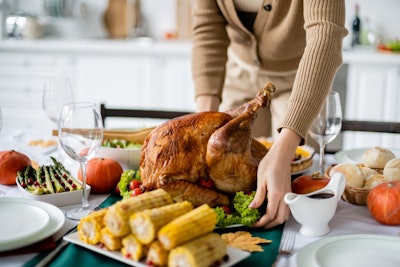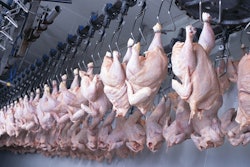
Turkey production in the U.S. declined by more than 10% over the past decade. Changing American tastes, animal disease and other market forces are driving the decline.
Production and consumption
According to WATT Global Media’s Top Turkey Company database, the total production of the top turkey companies included in WATT PoultryUSA’s survey declined to 6.336 billion pounds of live turkeys in 2022 from 7.433 billion in 2017.
Dr. Thomas Elam, president of FarmEcon LLC, said overall turkey production is down 10.1% from 2013 to 2022. But, 2022 was deeply affected by highly pathogenic avian influenza (HPAI) which caused a 6.1% decline in annual production.
“If we look at the 2012-2021 ten-year time frame, the decline was only 6.9%,” Elam said. “This is, unfortunately, part of a longer downward trend since 2008.”
Mark Jordan, executive director of LEAP Market Analytics, said overall ready-to-cook U.S. turkey production declined about 13% from 2012 to 2022. Much of that production decline, he said, occurred in the past five years.
Domestic per capita consumption of turkey is down about 10% between 2012 and 2022, Jordan said.
Elam said the domestic consumption of turkey doesn’t fully reflect the decline in production. He said total consumption decreased by 3.8% between 2013 and 2022. Per capita consumption is down 8.8% in the same period.
The average liveweight of turkeys increased to 31.3 pounds last year from 29.7 pounds in 2013, according to the National Turkey Federation (NTF).
Performance versus other proteins
This trend doesn’t compare favorably with the broiler, pork or beef markets. Elam said broiler production growth is up 18.7% from 2013 to 2022. Per capita consumption increased 17.8% during the same period. Jordan said broiler production increased 25% between 2012 and 2022 and consumption increased 23%.
Between 2012 and 2022, beef production increased by about 9%, per capita consumption increased by about 5% and overall consumption by 3%, Elam and Jordan said.
In the same timeframe, pork production increased by 16.4%, pork consumption increased 11% and per capita consumption grew by 5.4%, Elam and Jordan said.
Shopper preference
The whole bird market, once the hallmark of the holidays in the U.S., is changing. In the past five years, whole bird volume sales fell by 13% according to consumer data from Circana. Amanda Evans, a consultant for client insights at Circana, said whole chickens volumes saw a similar drop, falling by 12%.
Evans said turkey remains the fourth most popular fresh meat with U.S. shoppers, behind chicken, beef and pork.
In the grocery store, Evans said total turkey sales volume is down by 8% over the past five years. As of early May 2023, 1.1 billion pounds of turkey were sold in the last 52 weeks.
“This is driven by whole birds being down 12%,” Evans said. “But growing over (the past five) years are: ground, up 1%; backs and necks, up 2% and wings, up 39%.
Importantly, Evans said, even though pounds are down for turkey, dollar sales are up 20% compared with four years ago. In 2022, total turkey sales totaled $2.9 billion.
Factors behind the decline
No single event or market factor is pushing down on the production of turkey. Instead, HPAI, changing traditions, consumer behaviors and record high food price inflation all share a role.
In the store, Evans said whole bird declines play a huge role. Whole bird sales are falling during the critical, eight-week period around Thanksgiving in step with the rest of the year. The big bird is no longer king on the holiday.
“During Thanksgiving there are elevated sales for other meat types,” Evans said. “For example, lobster is up 38% over five years, but during the Thanksgiving time frame they are up 121%.”
Elam agreed, competition from other meats is increasing. He said turkey continues to struggle to find a place in the breakfast and dinner meals of retail or foodservice providers.
HPAI and COVID
The initial outbreak of HPAI in North America in 2014 and 2015 brought lingering effects to the turkey industry which impacted its long-term demand profile. Jordan attributed a large part of turkey’s slump to a consumer rejection of high turkey prices generated because of the disease.
After the 2015 outbreak, Jordan said, demand – and therefore prices – for turkey breasts dropped and remained weak until 2021. The COVID-19 pandemic caused a major shift away from the office and lunch out as workers moved home. Most workers headed back but many never will, causing a lasting impact to foodservice.
“(Turkey breast meat) is a very important revenue-driver for the industry,” Jordan said. “An extended slump in the turkey breast market contributed to a multi-year stretch of negative profitability across much of the industry.”
More troubling, the disease impacted supply, driving prices for the remaining meats higher. Buyers, corporate and consumer, began to find cheaper alternatives like boneless skinless breast meat or ham.
Brian Earnest, lead protein industry analyst, at CoBank said the COVID-19 pandemic caused a major shift in consumer behaviors, too. In 2020, demand for large bird meat destined for foodservice and institutional outlets evaporated.
“It was difficult to retain previous consumption levels, let alone grow consumption,” Earnest said. “So much of the decline in production can likely be attributed to those massive shifts in consumer behavior.
In a statement, NTF said the turkey industry lost about 10 million turkeys in 2022 to HPAI. About 7.4 million less birds were processed than in 2021. This also resulted in a 440-million-pound decline in total liveweight processed in 2022.
Elam expressed his concern about the long-term implications.
“In 2022, we saw white meat turkey and whole bird prices soar to record prices, surpassing the prior 2005 records by a significant margin,” Elam said. “These high prices rationed the lower available production. Those lost volume opportunities are going to be hard to win back.”


















